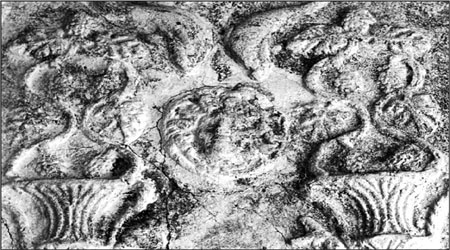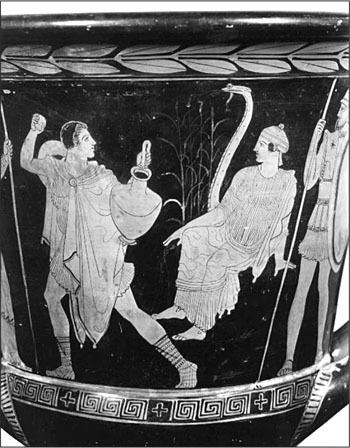The Good and Evil Serpent (30 page)
Read The Good and Evil Serpent Online
Authors: James H. Charlesworth

The founding of great cities is recorded in legends and myths featuring serpents. The Pythian games celebrated how Apollo founded Delphi by slaying the enormous serpent, Python, with his arrows, and helped bring order out of chaos after the great flood.
Likewise the myths about the founding of Thebes resonate with serpent imagery. Cadmus, in searching for Europa, the daughter of a king of Phoenicia, killed a large dragon or massive serpent that had annihilated his servants. The serpent had been sacred to Mars. The “Sown Men”
(Spartoi)
are brothers who evolve from the dragon’s or serpent’s teeth that had been planted in the earth. In his
Classical Art and the Cultures of Greece and Rome
, J. Onians astutely stresses the significance of the “Sown Men” who originate from snake’s teeth:
Snake’s teeth possess inherently, and more perfectly, many of the properties people sought in stone, and others besides. They are harder, sharper, more regular than even the most carefully finished blocks. They also fulfil a commander’s dream. Arrayed in three rows in the snake’s jaw those behind move up unbidden when necessary to replace those in front. A phalanx made of men who sprang from snake’s teeth was even better than one made of men who sprang from stones.
10
These reflections help us grasp the original meaning seen in this myth by many reflective Greeks and Romans. The story of Cadmus is tragic; he and his wife, Harmonia (the daughter of Venus), live harassed lives, because of Mars’ revenge. How does the story end? Both are turned into serpents.
Ophidian iconography thus not only shaped Greek myths and culture; it saturated them. At this stage in our work, it would be unwise to ask if the iconography and stories represented serpents embodying good or evil symbols. We ought rather to explore what are the many positive and negative meanings represented by the myriad of serpents in art, religion, and literature during the Greek and Roman eras. In this endeavor, we need to be aware of modern methods, or allegorical interpretations, which as R. Martin states, “dampen the rich, symbolic overtones and resonances in the myth.”
11
Since our focus has been the first century
CE
, before we begin an in-depth study of Greek and Roman ophidian or anguine iconography, we need to observe the major changes that occurred with the rise of the monarchy and the emperors. With the collapse of the Roman Republic, first with the civil war between Julius Caesar and Pompey and then between Octavian and Antony, Rome lost its hold on its own identity. The traditional patriarchal family units closely tied to farmers in Italy, France, Spain, and elsewhere had produced little art or literature.
When Rome militarily conquered Greece, Roman culture was intellectually conquered by Greek culture, especially in the spheres of art and iconography. The words of Horace are worth citing:
| Graecia capta ferum victorem cepit | | Captive Greece captured her untamed victor, |
| et artes intulit agresti Latio | | And brought the arts to countrified Latium. |
| [Epistles II, 1.156–57] | | [my idiomatic translation] |
The word “untamed” also represents wild and savage. The adjective “countrified” intends to evoke thoughts about the rustic, boorish, and agrarian world of the Romans. The noun “Latium” denotes the area near Rome. Both Greece and Rome are portrayed as “captured.” What does this signify? As R. Turcan states in
The Cults of the Roman Empire
(p. 2), Horace’s vision primarily means that “Greek civilization was a daughter of the East, as Roman civilization was the product of Greek education.”
When Octavian defeated Mark Antony and Cleopatra at Actium in 31
BCE
, he was faced with a nation and world that had been shattered and lost its powerful symbols. He wisely decided not to call himself “Romulus,” which would have brought up the unattractive concept of kingship. “Augustus” was a superb choice, whether it is related to
augere
“to increase,” or
augur
, one who interprets omens. As Florus stated, the title “Augustus” seemed to confer “divinity upon him” (2.34.66).
12
The Augustan Age thus saw the rebuilding of temples and the resurgence in the use of powerful and effective symbols. In the Roman world, Octavian was the son of Apollo and Antony the son of Dionysus. The latter had little chance for success, in the world of Roman symbolism, since prior to 31
BCE
there had already developed a strong pro-Apollo culture and polemics against Dionysus. Virgil, under the patronage of Augustus, helped create a new myth: Apollo had fought with Augustus against Antony and empowered him to conquer the world.
13
As P. Zanker states in
The Power of Images in the Age of Augustus
, scarcely in history has art been “pressed into the service of political power so directly as in the Age of Augustus.”
14
Horace had predicted that Rome would remain “sullied with the guilt of your fathers, until you have rebuilt the temples and restored all the ruined sanctuaries”
(Carmen
3.6). It is thus a paradigmatic shift in the history of Roman iconography and art to hear Augustus claim: “I restored 82 temples of the gods of Rome and did not omit a single one which was at that time in need of renewal”
(Res Gestae
20).
15
While this claim seems unrealistic, it does place the religious revival under Augustus.

Figure 48
. Bronze Sarcophagus. Two dolphins above and two baskets filled with fruit framing a Medusa with serpents in her hair. Circa third-sixth century CE. JHC Collection
It is this perspective that will inform our research. Some, perhaps many, studies of ancient Roman art and iconography have given insufficient attention to the political power struggle that marred the first century
BCE
. These historical forces frame the meaning often poured into art, architecture, and iconography. It is in this context and with this perception that Greek and later Roman ophidian iconography will be collected and assessed. Under Augustus in the West and in the East (after 70
CE
when Jerusalem was burned) Hellenistic culture could flourish under a world peace, when poetry and art could thrive with imaginings of a better and blessed world ahead. As texts need contexts to reveal their meanings, so iconography is best studied in light of what we can discern about the history behind, and perhaps mirrored within, it.
The educated today, when prompted to think about serpent symbolism in Greek and Roman antiquity, would most likely suggest some images that have been ingrained in our modern consciousness (and the unconscious).
16
The image of Laocoon struggling with large serpents might be suggested because of the monumental sculptures seen in museums and in photographs (as we indicated earlier).
17
The Minoan goddess holding aloft from each hand two writhing serpents would probably come to mind,
18
not least because of her impressive breasts, seductively exposed.
19
The image of Medusa with serpents crawling in her hair is so well known and ubiquitous in modern culture that even the untutored might mention this anguine symbol in a discussion. The contemporary mind might remember also depictions of Hercules wrestling with serpents,
20
perhaps because the image is so well disseminated in our Western culture.
21
For example, in Dresden’s Skulpturensammlung is a bronze sculpture of Hercules (probably not Laocoon as some think). It is by Francesco di Giorgio Martini and is dated 1495. In Hercules’ uplifted left hand is a captured serpent that curls along his arm.
The amount of anguine iconography from the Greek and Roman world is remarkable.
22
The evidence comes from virtually every part of the world known to the Greeks and Romans. The serpent was not highlighted in ornamental jewelry merely for decoration, as we demonstrated earlier;
23
it had religious and symbolic meanings. Fountains were sometimes decorated not only with nymphs but also water serpents.
24
In the following pages, I will present a selection of these data, now focusing on literary texts. The amount of attention the Greeks and Romans gave to serpent imagery will most likely prove astounding to many scholars.
Before proceeding further with an examination of the meaning of ophidian iconography and symbology in the Greek and Roman worlds, we should bring into focus that there are forty-one names for snake taxonomy in Greek (see
Appendix II
). The Greeks also had a word for “belonging to serpents.” In fact, that same word,
ophiakos
, also denoted “a form of leprosy in which the patient sheds his skin like a snake.” The richness of Greek vocabulary in regard to snakes is remarkable. The Greeks had words for “the food of serpents,” “serpent-eating,” “serpent-chaser,” “serpent-killer,” “serpent-fighter,” “snake charmer.” The Greeks were able to denote with one word “serpent-tailed,” “serpent-eating,” and “serpent-bearing.”
25
It is certain that we cannot represent in English the exact meanings of some Greek terms and that the Greeks knew more about serpents than English-speaking people. The Greeks were different from us; they were much closer to our earth than most of us.
Serpents on Vases
Serpent iconography on vases reaches a high level in the second half of the seventh century
BCE
. It flourished especially in Corinth. Artwork of a certain type is so unusual that it is referred to as the work of the “Snake Painter.”
26
The artwork is elegant, often with stunning black figures on white ware. The serpent is usually raised, with a triangular head, and with six curves—probably to indicate power and mobility.
27

Figure 49
. Large Upright Serpent with Harmonia Seated. Greek vase. Metropolitan Museum of Art 07.286.66.
Gods and Goddesses as Part Snake
The veneration of Isis continued into the Greek and Roman periods with some modification. She is portrayed sometimes with a woman’s face and a serpent’s body. The ceramic serpent images shown in
Figs. 50
and
51
probably portray Isis with a serpent’s torso. They date from around 100
BCE
, most likely, and were obtained in Israel. Reputedly, the one that is not broken was found south of Ashkelon and the broken one in the vicinity of Jerusalem. The broken one depicts an Isis with a serpent’s body, a high crown
(polos)
, and a torch. Both are similar to the first-century
BCE
sandstone stele of the snake-bodied Isis and Dionysus in the British Museum.
28
Isis was portrayed not only as partly serpentine, but also holding a cobra,
29
or with two large serpents.
30
Like Asclepius who appears ubiquitously holding a staff
31
around which is curled a serpent,
32
Isis is also imagined as an upraised cobra with its hood extended.
33
It is now clear that the Egyptian Isis cult was active in Rome, especially in the coastal cites, like Venice, ancient Ostia, and particularly Aquileia.
34